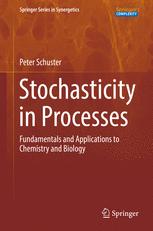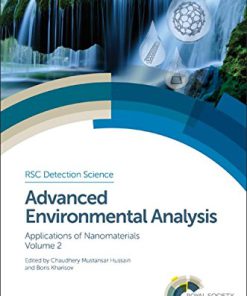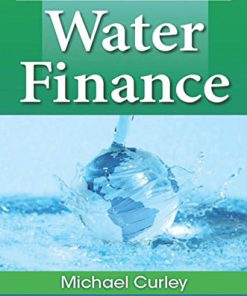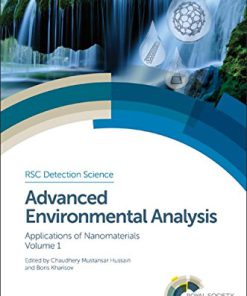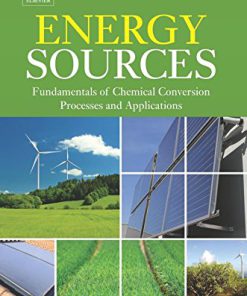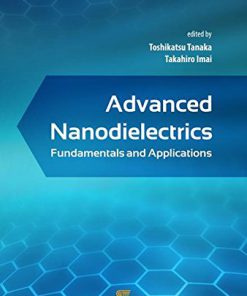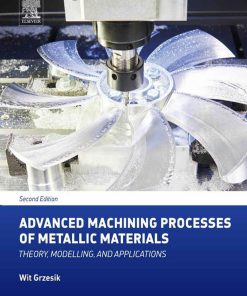Chemistry of Advanced Environmental Purification Processes of Water Fundamentals and Applications 1st Edition by Erik Sogaard ISBN 0080932401 9780080932408
$50.00 Original price was: $50.00.$25.00Current price is: $25.00.
Chemistry of Advanced Environmental Purification Processes of Water Fundamentals and Applications 1st Edition by Erik Sogaard – Ebook PDF Instant Download/Delivery: 0080932401, 978- 0080932408
Full download Chemistry of Advanced Environmental Purification Processes of Water Fundamentals and Applications 1st Edition after payment
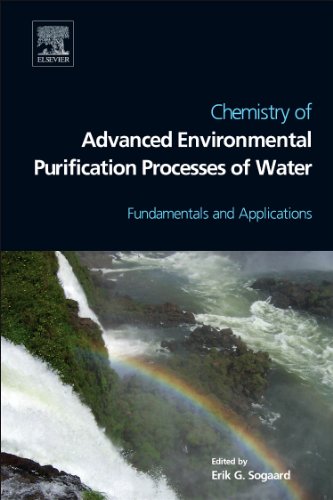
Product details:
ISBN 10: 0080932401
ISBN 13: 978-0080932408
Author: Erik Sogaard
Chemistry of Advanced Environmental Purification Processes of Water covers the fundamentals behind a broad spectrum of advanced purification processes for various types of water, showing numerous applications through worked examples. Purification processes for groundwater, soil water, reusable water, and raw water are examined where they are in use full-scale, as a pilot approach, or in the laboratory. This book also describes the production of ceramic particles (nanochemistry) and materials for the creation of filtration systems and catalysts that are involved.
- Uses chemistry fundamentals to explain the mechanisms behind the various purification processes
- Explains in detail process equipment and technical applications
- Describes the production of ceramic particles and other new materials applicable to filtration systems
- Includes worked examples
Chemistry of Advanced Environmental Purification Processes of Water Fundamentals and Applications 1st Table of contents:
Chapter 1: Water and Water Cycle
- 1.1. Origin of Water: This section likely covers the natural origins of water, discussing theories and processes that contribute to water formation on Earth.
- 1.2. Rainwater, Groundwater and Drinking Water: Examines the sources of water, including rainwater, groundwater, and their purification for consumption.
- 1.3. Wastewater: Focuses on wastewater, its treatment, and management, including how wastewater can be reused or safely disposed of.
Chapter 2: In Situ Chemical Oxidation (ISCO)
- 2.1. Introduction: An introduction to ISCO as a method used to treat contaminated groundwater or soil using chemical oxidation.
- 2.2. Fundamentals of ISCO: Discusses the basic principles and mechanisms of ISCO, explaining how chemicals are used to break down pollutants in situ.
- 2.3. Case Study: Kærgaard Plantation: A case study illustrating the application of ISCO at the Kærgaard plantation site.
- 2.4. Bench and Pilot Tests: The role of laboratory tests and pilot projects in determining the effectiveness of ISCO.
- 2.5. Metal Mobilisation: Describes how ISCO can mobilize metals in the environment, which can be both beneficial or problematic depending on the situation.
- 2.6. Scavenging of Hydroxyl Radicals: Explains the interactions between hydroxyl radicals and contaminants during the ISCO process.
- 2.7. Conclusion: Summary of key findings and conclusions from the chapter.
- 2.8. Perspectives and Future Research: Discusses future opportunities and challenges for ISCO technology.
Chapter 3: Electrochemical Oxidation – A Versatile Technique for Aqueous Organic Contaminant Degradation
- 3.1. Introduction: Overview of electrochemical oxidation (EO) as a method for degrading organic contaminants in water.
- 3.2. The Principle and Mechanisms in EO: Explains how EO works, the chemical mechanisms involved, and the types of contaminants it targets.
- 3.3. The Versatility of EO Degradation: Highlights the broad applications of EO in treating various organic pollutants.
- 3.4. The Challenge of Minimising By-product Formation: Discusses the issue of by-products created during EO and strategies for minimizing them.
- 3.5. Examples of Application of EO: Provides examples of real-world applications where EO has been successfully used to treat water.
- 3.6. Implementation of EO in Large Scale – Combined Treatment: Describes the potential for implementing EO on a large scale, potentially combined with other treatment methods.
- 3.7. Perspectives: Looks at future research directions and improvements in EO technology.
Chapter 4: Heterogeneous Photocatalysis
- 4.1. Introduction: Introduces heterogeneous photocatalysis as a technique for water treatment, especially for breaking down organic contaminants.
- 4.2. The Principle and Mechanisms in Semiconductor Photocatalysis: Explains how semiconductor materials are used in photocatalysis to accelerate chemical reactions using light.
- 4.3. TiO2 Photocatalysis: Focuses on the use of titanium dioxide (TiO2) as a common photocatalyst in water treatment.
- 4.4. Case Study 1 – Photocatalytic Oxidation of Disinfection By-products in Swimming Pool Water: A case study that explores the use of photocatalysis to remove harmful by-products from swimming pool water.
- 4.5. Case Study 2 – Comparison of the Oxidation Efficiency of UV-Activated AOP Techniques: Compares the effectiveness of UV-activated advanced oxidation processes (AOPs) in photocatalysis.
- 4.6. Summary: A recap of the chapter’s key findings and concepts.
Chapter 5: Near- and Supercritical Water
- 5.1. Properties of the Supercritical Phase: Discusses the properties of water when it is in the supercritical state, where it behaves differently than in typical liquid or gas phases.
- 5.2. Properties of Supercritical Water: Explores the characteristics of supercritical water, including its density, solvency, and other unique traits that make it useful in water treatment.
- 5.3. Applications of Supercritical Water: Reviews various applications for supercritical water in environmental treatment and chemical processes.
- 5.4. Summary: Provides a summary of the key concepts and potential uses of supercritical water.
Chapter 6: Membrane Filtration in Water Treatment – Removal of Micropollutants
- 6.1. Introduction: Overview of membrane filtration as a technique for removing micropollutants (small organic and inorganic substances) from water.
- 6.2. Types of Membranes and Membrane Processes: Describes the various types of membranes (e.g., reverse osmosis, ultrafiltration) and how they function in water treatment.
- 6.3. Filtration Techniques and Membrane Module Configuration: Details the configurations of filtration systems and their operational characteristics.
- 6.4. Filtration Theory – Concepts and Models: Explains the scientific principles behind filtration processes and models that predict their efficiency.
- 6.5. Issues for Membranes Filtration – Fouling and Scaling: Discusses challenges in membrane filtration, particularly fouling (clogging) and scaling (mineral buildup).
- 6.6. Versatility of Membranes – Examples of Applications: Highlights the flexibility of membranes in various water treatment applications.
- 6.7. Membranes for Micropollutant Removal: Focuses on the use of membranes to target and remove micropollutants specifically.
- 6.8. Membranes in AOPs: Discusses the integration of membranes with advanced oxidation processes to enhance water treatment.
Chapter 7: Advanced Iron Oxidation at Drinking Water Treatment Plants
- 7.1. Drinking Water Treatment in Denmark: An overview of drinking water treatment practices in Denmark, particularly the use of iron oxidation.
- 7.2. Drinking Water Standards in the EU and Denmark: Discusses regulatory standards for drinking water quality in Denmark and the EU.
- 7.3. A Typical Drinking Water WTP for Simple Water Treatment in Denmark (Vr. Gjesing WTP): Describes a typical water treatment plant (WTP) in Denmark and how iron oxidation is applied.
- 7.4. Astrup Drinking WTP Using Advanced Biological Filtration: Focuses on a water treatment plant using biological filtration methods for iron removal.
- 7.5. Biotic Conditions for Iron Precipitation: Examines the biological conditions necessary for effective iron precipitation during treatment.
- 7.6. Functions of Exopolymers in Sand Filters: Explores the role of exopolymers in enhancing filtration efficiency in sand filters.
- 7.7. Content of the Fe Bacterial Stalk: Discusses the presence of iron-associated bacteria in drinking water filtration and their role in the process.
- 7.8. Conclusion: Summarizes the findings related to advanced iron oxidation and its application in drinking water treatment.
Chapter 8: Advanced Arsenic Removal Technologies Review
- 8.1. Introduction: Introduction to the issue of arsenic contamination in water and the importance of removing it.
- 8.2. Removal Technologies: Reviews the technologies available for arsenic removal, such as adsorption, filtration, and chemical treatments.
- 8.3. Arsenic in Stable Solid State: Discusses methods for stabilizing arsenic in solid form after removal to prevent re-contamination.
- 8.4. Example of Simple Arsenic Removal Technology: Provides an example of a simple, cost-effective technology for removing arsenic from water.
People also search for Chemistry of Advanced Environmental Purification Processes of Water Fundamentals and Applications 1st :
chemistry of advanced environmental purification processes of water
weightage of environmental chemistry in jee advanced
advanced environmental chemistry
what is environmental chemistry all about
environmental engineering chemistry
Tags:
Erik Sogaard,Chemistry,Advanced,Environmental,Purification,Processes,Water,Fundamentals,Applications 1st
You may also like…
Science (General)
Science (General) Biology and other natural sciences - Ecology
Fundamentals of Environmental and Toxicological Chemistry Sustainable Science Fourth Edition Manahan
Engineering
Engineering
Advanced machining processes of metallic materials : theory, modelling and applications Wit Grzesik




